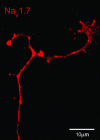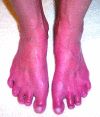Mutations in sodium-channel gene SCN9A cause a spectrum of human genetic pain disorders
- PMID: 18060017
- PMCID: PMC2096434
- DOI: 10.1172/JCI33297
Mutations in sodium-channel gene SCN9A cause a spectrum of human genetic pain disorders
Abstract
The voltage-gated sodium-channel type IX alpha subunit, known as Na(v)1.7 and encoded by the gene SCN9A, is located in peripheral neurons and plays an important role in action potential production in these cells. Recent genetic studies have identified Na(v)1.7 dysfunction in three different human pain disorders. Gain-of-function missense mutations in Na(v)1.7 have been shown to cause primary erythermalgia and paroxysmal extreme pain disorder, while nonsense mutations in Na(v)1.7 result in loss of Na(v)1.7 function and a condition known as channelopathy-associated insensitivity to pain, a rare disorder in which affected individuals are unable to feel physical pain. This review highlights these recent developments and discusses the critical role of Na(v)1.7 in pain sensation in humans.
Figures




Similar articles
-
Congenital insensitivity to pain: novel SCN9A missense and in-frame deletion mutations.Hum Mutat. 2010 Sep;31(9):E1670-86. doi: 10.1002/humu.21325. Hum Mutat. 2010. PMID: 20635406 Free PMC article.
-
An SCN9A channelopathy causes congenital inability to experience pain.Nature. 2006 Dec 14;444(7121):894-8. doi: 10.1038/nature05413. Nature. 2006. PMID: 17167479 Free PMC article.
-
Novel SCN9A mutations underlying extreme pain phenotypes: unexpected electrophysiological and clinical phenotype correlations.J Neurosci. 2015 May 20;35(20):7674-81. doi: 10.1523/JNEUROSCI.3935-14.2015. J Neurosci. 2015. PMID: 25995458 Free PMC article.
-
Genetics and molecular pathophysiology of Na(v)1.7-related pain syndromes.Adv Genet. 2008;63:85-110. doi: 10.1016/S0065-2660(08)01004-3. Adv Genet. 2008. PMID: 19185186 Review.
-
Pain disorders and erythromelalgia caused by voltage-gated sodium channel mutations.Curr Neurol Neurosci Rep. 2012 Feb;12(1):76-83. doi: 10.1007/s11910-011-0233-8. Curr Neurol Neurosci Rep. 2012. PMID: 21984269 Review.
Cited by
-
Application of Pharmacokinetic-Pharmacodynamic Modeling to Inform Translation of In Vitro NaV1.7 Inhibition to In Vivo Pharmacological Response in Non-human Primate.Pharm Res. 2020 Sep 4;37(10):181. doi: 10.1007/s11095-020-02914-9. Pharm Res. 2020. PMID: 32888082 Free PMC article.
-
Recent Developments of Novel Pharmacologic Therapeutics for Prevention of Chemotherapy-Induced Peripheral Neuropathy.Clin Cancer Res. 2019 Nov 1;25(21):6295-6301. doi: 10.1158/1078-0432.CCR-18-2152. Epub 2019 May 23. Clin Cancer Res. 2019. PMID: 31123053 Free PMC article. Review.
-
A novel Nav1.7 mutation producing carbamazepine-responsive erythromelalgia.Ann Neurol. 2009 Jun;65(6):733-41. doi: 10.1002/ana.21678. Ann Neurol. 2009. PMID: 19557861 Free PMC article.
-
Sporadic Erythromelalgia Associated with a Homozygous Carrier of Common Missense Polymorphism in SCN9A Gene Coding for NaV1.7 Voltage-gated Sodium Channel.Cureus. 2019 May 2;11(5):e4587. doi: 10.7759/cureus.4587. Cureus. 2019. PMID: 31309012 Free PMC article.
-
Understanding the genetic basis of congenital insensitivity to pain.Br Med Bull. 2020 May 15;133(1):65-78. doi: 10.1093/bmb/ldaa003. Br Med Bull. 2020. PMID: 32219415 Free PMC article. Review.
References
-
- Zubieta J.K., et al. COMT val158met genotype affects mu-opioid neurotransmitter responses to a pain stressor. Science. 2003;299:1240–1243. - PubMed
-
- Ophoff R.A., et al. Familial hemiplegic migraine and episodic ataxia type-2 are caused by mutations in the Ca2+ channel gene CACNL1A4. Cell. 1996;87:543–552. - PubMed
-
- Drenth J.P., et al. SCN9A mutations define primary erythermalgia as a neuropathic disorder of voltage gated sodium channels. J. Invest. Dermatol. 2005;124:1333–1338. - PubMed
-
- Han C., et al. Sporadic onset of erythermalgia: a gain-of-function mutation in Nav1.7. Ann. Neurol. 2006;59:553–558. - PubMed
Publication types
MeSH terms
Substances
LinkOut - more resources
Full Text Sources
Other Literature Sources
Medical

